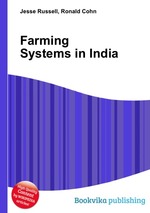Farming Systems in India
Jesse Russell Ronald Cohn
бумажная книга
High Quality Content by WIKIPEDIA articles! India comprises various farming systems that are strategically utilized, according to the locations where they are most suitable. The farming systems that significantly contribute to the domestic GDP of India are subsistence farming, organic farming, and industrial farming. Regions throughout India differ in types of farming they use; some are based on horticulture, ley farming, agroforestry, and many more. Due to India`s geographical location, certain parts experience different climates, thus affecting each region`s agricultural productivity differently. India is very dependent on its monsoon-based periodic rainfall. If it weren`t for large government involvement in storage of water for agricultural irrigation, only some parts of India would receive rainfall throughout the year, making many other regions arid. Dependency on these monsoons is risky because there are great variations in the average amount of rainfall received by the various regions—from too much for most crops in the eastern Himalayas to never enough in Rajasthan. Season-to-season variations of rainfall are also significant and the consequences of these are bumper harvests and crop searing. For this reason, irrigation in India is one of the main priorities in Indian farming.


